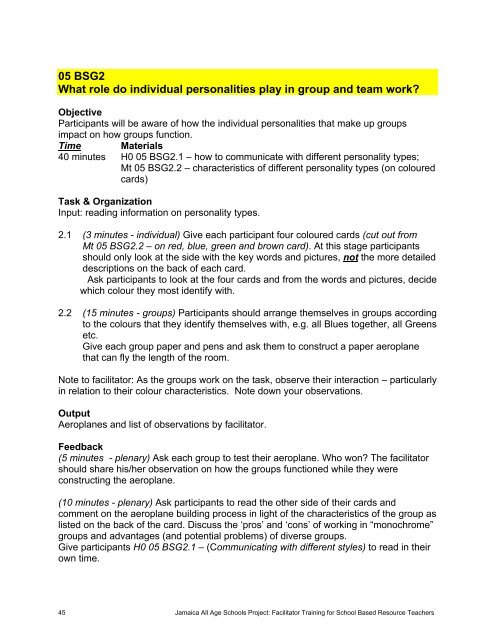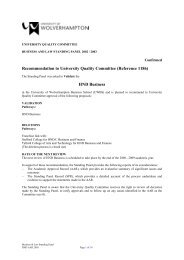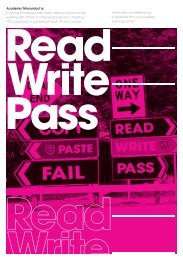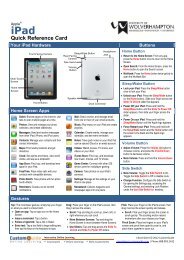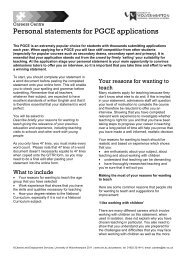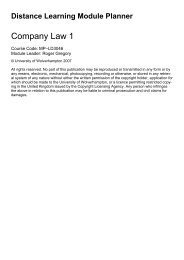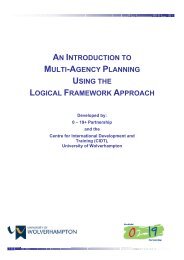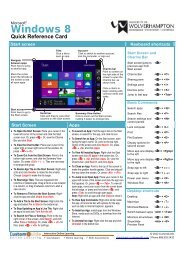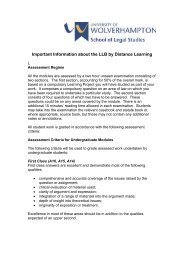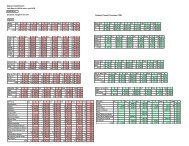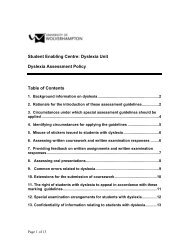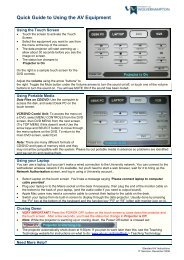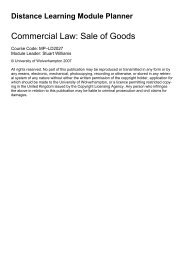This activity can be found in Pretty et al, (1995) - University of ...
This activity can be found in Pretty et al, (1995) - University of ...
This activity can be found in Pretty et al, (1995) - University of ...
- No tags were found...
Create successful ePaper yourself
Turn your PDF publications into a flip-book with our unique Google optimized e-Paper software.
05 BSG2What role do <strong>in</strong>dividu<strong>al</strong> person<strong>al</strong>ities play <strong>in</strong> group and team work?ObjectiveParticipants will <strong>be</strong> aware <strong>of</strong> how the <strong>in</strong>dividu<strong>al</strong> person<strong>al</strong>ities that make up groupsimpact on how groups function.Time40 m<strong>in</strong>utesMateri<strong>al</strong>sH0 05 BSG2.1 – how to communicate with different person<strong>al</strong>ity types;Mt 05 BSG2.2 – characteristics <strong>of</strong> different person<strong>al</strong>ity types (on colouredcards)Task & OrganizationInput: read<strong>in</strong>g <strong>in</strong>formation on person<strong>al</strong>ity types.2.1 (3 m<strong>in</strong>utes - <strong>in</strong>dividu<strong>al</strong>) Give each participant four coloured cards (cut out fromMt 05 BSG2.2 – on red, blue, green and brown card). At this stage participantsshould only look at the side with the key words and pictures, not the more d<strong>et</strong>aileddescriptions on the back <strong>of</strong> each card.Ask participants to look at the four cards and from the words and pictures, decidewhich colour they most identify with.2.2 (15 m<strong>in</strong>utes - groups) Participants should arrange themselves <strong>in</strong> groups accord<strong>in</strong>gto the colours that they identify themselves with, e.g. <strong>al</strong>l Blues tog<strong>et</strong>her, <strong>al</strong>l Greens<strong>et</strong>c.Give each group paper and pens and ask them to construct a paper aeroplan<strong>et</strong>hat <strong>can</strong> fly the length <strong>of</strong> the room.Note to facilitator: As the groups work on the task, observe their <strong>in</strong>teraction – particularly<strong>in</strong> relation to their colour characteristics. Note down your observations.OutputAeroplanes and list <strong>of</strong> observations by facilitator.Feedback(5 m<strong>in</strong>utes - plenary) Ask each group to test their aeroplane. Who won? The facilitatorshould share his/her observation on how the groups functioned while they wereconstruct<strong>in</strong>g the aeroplane.(10 m<strong>in</strong>utes - plenary) Ask participants to read the other side <strong>of</strong> their cards andcomment on the aeroplane build<strong>in</strong>g process <strong>in</strong> light <strong>of</strong> the characteristics <strong>of</strong> the group aslisted on the back <strong>of</strong> the card. Discuss the ‘pros’ and ‘cons’ <strong>of</strong> work<strong>in</strong>g <strong>in</strong> “monochrome”groups and advantages (and potenti<strong>al</strong> problems) <strong>of</strong> diverse groups.Give participants H0 05 BSG2.1 – (Communicat<strong>in</strong>g with different styles) to read <strong>in</strong> theirown time.45 Jamaica All Age Schools Project: Facilitator Tra<strong>in</strong><strong>in</strong>g for School Based Resource Teachers


